第六章 角蛋白 PPT课件
第六章 角蛋白
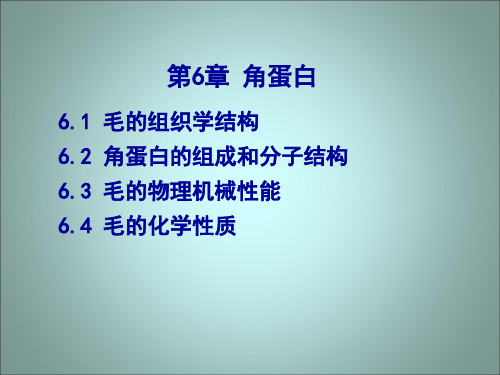
毛的角蛋白纤维
Ⅰ型和Ⅱ型肽链
首尾轻度重 叠且交联
中间纤丝的结构模型
6.3 毛的物理机械性能
1.纺织用毛 2.毛的物理机械性能
1.纺织用毛
绵羊:绵羊毛、绵羊绒 山羊:山羊毛、山羊绒 骆驼:骆驼毛、骆驼绒 驼羊:驼羊毛、骆马毛、秘鲁羊毛 兔:兔毛、安哥拉兔毛、其它兔毛 其它动物:牦牛绒
亚硫酸盐
HC H2 C S S H2 C CH2 + NaHSO3 SH H2C CH + HC H2 C S SO3Na
半胱氨酰
S-磺基丙氨酰
常用的巯基封闭剂——碘化甲基汞CH3HgI
硫化钠、硫氢化钠
Na 2S
CH2 S S CH2
NaHS + NaOH
+ 2NaHS 2 CH 2SH + Na2 S 2
4H 2 o
8
SO H + 5Cl 2 3
还原剂的作用——溶解或改性角蛋白
发生位置:双硫键
双硫键的还原是一个可逆的平衡反应,过量的
还原剂有利于双硫键的还原。
硫代物和硫化物、膦化物膦化物、亚硫酸盐等 都是双硫键的有效还原剂。
硫代物和硫化物
主要有巯基乙醇、邻甲苯硫酚、巯基乙酸、硫化钠等
双硫键的交换反应----亲核取代
2. 碱的作用 –
碱对双硫键的水解作用、对盐
键、肽键的作用
角蛋白对碱极敏感,影响的程度与时间、
温度、浓度及碱的性质有关。
碱与双硫键的反应
CO HC NH CH2 S S CH 2 CO CH NH
OH -
CO C CH2 S S CH 2
CO CH NH
H2 O
NH
生物化学王镜岩第三第六章蛋白质的高级结构 课件(共54张PPT)

弹性蛋白:存在于结缔组织
纤维状蛋白质
不溶性〔硬 蛋白〕
角蛋白
α角蛋白:主要存在于毛发中
β角蛋白:天然存在于丝中,丝 心蛋白
胶原蛋白:结缔组织中〔骨、皮肤等〕大量存 在
可溶性蛋 白
肌球蛋白
血纤蛋白原
其它
说明: α角蛋白经充分伸展后可转变成β角蛋白,即β折叠片结构。
(4) 无规那么卷曲〔nonregular coil〕 蛋白质的空间结构:二级结构单元〔 -螺旋、 -折叠、 -转角、自由回转〕、三级与四级结构〔超二级结构、结构域、亚基〕及结构与功 能的关系 特征:两条或多条伸展的多肽链〔或一条多肽链的假设干肽段〕侧向集聚,通过相邻肽链主链上的N-H与C=O之间有规那么的氢键,形成锯齿 状片层结构,即β-折叠片。 70年代,提倡Vitamin C治百病 2 、 螺旋体中所有氨基酸残基R侧链都伸向外侧,链中的全部>C=0 和>N-H几乎都平行于螺旋轴;
4. 蛋白质的超二级结构
(1)超二级结构〔 supersecondary structure 〕 蛋白质中相邻的二级结构单位〔即单个α-螺
旋或β-折叠或β-转角〕组合在一起,形成有规 那么的、在空间上能辩认的二级结构组合体称为蛋 白质的超二级结构
根本组合方式:αα;β×β;βββ
超二级结构类型
αα
Β-链
β×β
βαβ
1 2ββ--迂迂回3 回4 5
βββ
回形拓扑结构
5 2回形3 拓扑4 结1构
丙糖磷酸异构酶
乳酸脱氢酶结构域1
黄素蛋白
丙酮酸激酶结构域4
羧肽酶
腺苷酸激酶
(a)
()
平行 -折叠的结构比较〔a〕 -园桶形排布,〔b〕马蹄形排布
角蛋白
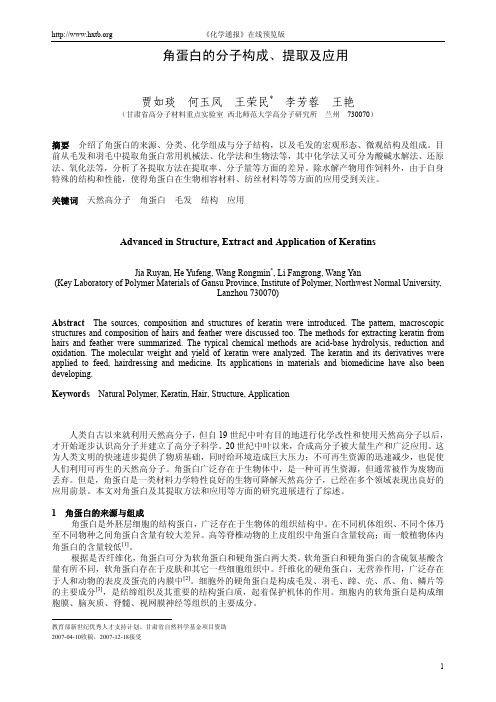
角蛋白的分子构成、提取及应用贾如琰何玉凤王荣民*李芳蓉王艳(甘肃省高分子材料重点实验室西北师范大学高分子研究所兰州 730070)摘要介绍了角蛋白的来源、分类、化学组成与分子结构,以及毛发的宏观形态、微观结构及组成。
目前从毛发和羽毛中提取角蛋白常用机械法、化学法和生物法等,其中化学法又可分为酸碱水解法、还原法、氧化法等,分析了各提取方法在提取率、分子量等方面的差异。
除水解产物用作饲料外,由于自身特殊的结构和性能,使得角蛋白在生物相容材料、纺丝材料等等方面的应用受到关注。
关键词天然高分子角蛋白毛发结构应用Advanced in Structure, Extract and Application of KeratinsJia Ruyan, He Yufeng, Wang Rongmin*, Li Fangrong, Wang Yan(Key Laboratory of Polymer Materials of Gansu Province, Institute of Polymer, Northwest Normal University,Lanzhou 730070)Abstract The sources, composition and structures of keratin were introduced. The pattern, macroscopic structures and composition of hairs and feather were discussed too. The methods for extracting keratin from hairs and feather were summarized. The typical chemical methods are acid-base hydrolysis, reduction and oxidation. The molecular weight and yield of keratin were analyzed. The keratin and its derivatives were applied to feed, hairdressing and medicine. Its applications in materials and biomedicine have also been developing.Keywords Natural Polymer, Keratin, Hair, Structure, Application人类自古以来就利用天然高分子,但自19世纪中叶有目的地进行化学改性和使用天然高分子以后,才开始逐步认识高分子并建立了高分子科学。
角蛋白
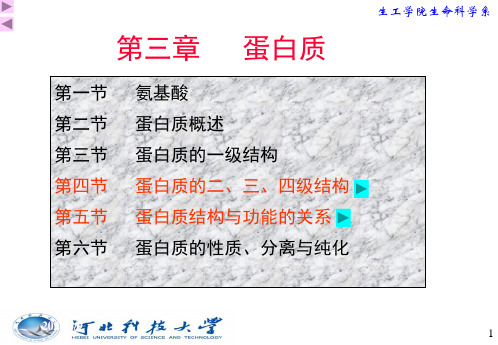
2021/4/9
4
生工学院生命科学系
三、蛋白质天然折叠结构决定因素
➢ 多肽主链折叠的空间限制
➢ 二面角决定肽链的构象
➢ 氨基酸序列规定蛋白质的三维结构
➢ RNase复性的经典实验
2021/4/9
5
四、蛋白质的三维结构
(一)二级结构 (二)超二级结构和结构域 (三)三级结构 (四)四级结构
2021/4/9
15
2.-角蛋白( -折叠片蛋白质)
丝心蛋白:具有高的抗张强度、 柔软、有一定的伸展度。
(二)超二级结构和结构域
1.超二级结构 2 结构域Biblioteka 2021/4/917
1.超二级结构:
第220页
超二级结构:是指蛋白质中相邻的二级单元组合在一起,彼此 相互作用,形成有规则的、在空间上能辨认的二级结构组合体。 ➢ 常见的3种基本组合形式:αα、 βαβ 、 ββ
生工学院生命科学系
2.结构域(Domain) :
多肽链在二级结构或者超二级结构的基础上形成三级结构的局 部折叠区,是相对独立的紧密球状实体,称为结构域或者叫做 域。
结构域有时候也叫功能域
2021/4/9
22
(三)三级结构
生工学院生命科学系
➢三级结构:是建立在二级结构、超二级结构乃至结构域的基础上 的,多肽链进一步折叠卷曲形成复杂的球状分子结构,称为三级 结构。
第三章 蛋白质
生工学院生命科学系
第一节 第二节 第三节 第四节 第五节 第六节
氨基酸 蛋白质概述 蛋白质的一级结构 蛋白质的二、三、四级结构 蛋白质结构与功能的关系 蛋白质的性质、分离与纯化
2021/4/9
1
第四节 蛋白质的三维结构(构象)
细胞角蛋白

细胞角蛋白的组装:
• 细胞角蛋白单体通过蛋白质相互作用组装成多聚体
• 细胞角蛋白多聚体在细胞中形成纤维网络,维持细胞的形态和结构稳定
细胞角蛋白在细胞生物学中的作用
细胞角蛋白在细胞形态维持中的作用:
• 细胞角蛋白通过细胞骨架与细胞膜相互作用,维持细胞的形状和尺寸
• 基因检测:用于检测细胞角蛋白基因的突变和异常表达
肿瘤的早期诊断和风险评估
细胞角蛋白在肿瘤治疗中的应用
细胞角蛋白在肿瘤治疗中的意义:
细胞角蛋白在肿瘤治疗中的应用方法:
• 细胞角蛋白的合成和降解调控在肿瘤发生和发展中具有
• 靶向治疗:针对细胞角蛋白的合成和降解途径,开发靶
重要作用,可作为肿瘤治疗的靶点
Docs
向治疗药物
• 细胞角蛋白的异常表达与肿瘤的恶性程度和预后密切相
• 免疫治疗:利用细胞角蛋白的抗原性,开发肿瘤免疫治
关,可用于肿瘤的个体化治疗
疗策略
细胞角蛋白在其他疾病诊断与治疗中的应用前景
细胞角蛋白在神经退行性疾病诊断与治疗中的应用前景:
• 细胞角蛋白在神经退行性疾病的发生和发展中具有重要作用,可作为疾病诊断和
• Ⅱ型细胞角蛋白主要存在于神经细胞中,参与细胞信号传导和细胞骨架的构建
• Ⅲ型细胞角蛋白主要存在于肌肉细胞中,负责维持肌肉细胞的收缩功能
• Ⅳ型细胞角蛋白主要存在于基底膜中,参与细胞外基质的构建
细胞角蛋白的研究进展与应用领域
细胞角蛋白的研究进展:
细胞角蛋白的应用领域:
• 近年来,对细胞角蛋白的合成机制、降解途径和生物学
• 外源性细胞角蛋白是通过饮食摄入的
• 细胞角蛋白在细胞中的稳定性使其成为研究的热点
角蛋白1
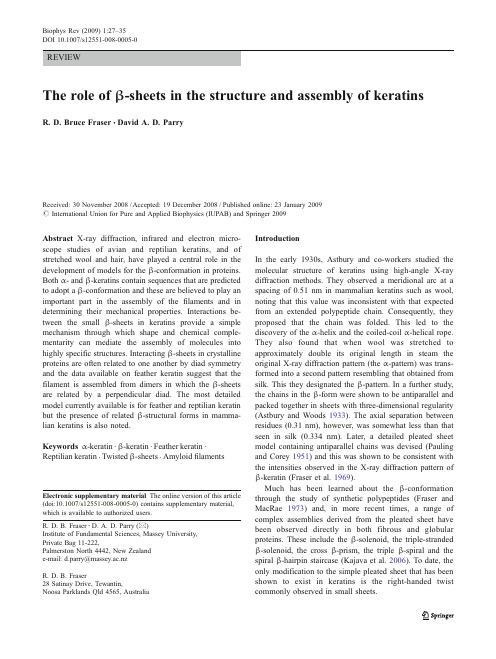
REVIEWThe role ofβ-sheets in the structure and assembly of keratins R.D.Bruce Fraser&David A.D.ParryReceived:30November2008/Accepted:19December2008/Published online:23January2009#International Union for Pure and Applied Biophysics(IUPAB)and Springer2009Abstract X-ray diffraction,infrared and electron micro-scope studies of avian and reptilian keratins,and of stretched wool and hair,have played a central role in the development of models for theβ-conformation in proteins. Bothα-andβ-keratins contain sequences that are predicted to adopt aβ-conformation and these are believed to play an important part in the assembly of the filaments and in determining their mechanical properties.Interactions be-tween the smallβ-sheets in keratins provide a simple mechanism through which shape and chemical comple-mentarity can mediate the assembly of molecules into highly specific structures.Interactingβ-sheets in crystalline proteins are often related to one another by diad symmetry and the data available on feather keratin suggest that the filament is assembled from dimers in which theβ-sheets are related by a perpendicular diad.The most detailed model currently available is for feather and reptilian keratin but the presence of relatedβ-structural forms in mamma-lian keratins is also noted.Keywordsα-keratin.β-keratin.Feather keratin. Reptilian keratin.Twistedβ-sheets.Amyloid filaments IntroductionIn the early1930s,Astbury and co-workers studied the molecular structure of keratins using high-angle X-ray diffraction methods.They observed a meridional arc at a spacing of0.51nm in mammalian keratins such as wool, noting that this value was inconsistent with that expected from an extended polypeptide chain.Consequently,they proposed that the chain was folded.This led to the discovery of theα-helix and the coiled-coilα-helical rope. They also found that when wool was stretched to approximately double its original length in steam the original X-ray diffraction pattern(theα-pattern)was trans-formed into a second pattern resembling that obtained from silk.This they designated theβ-pattern.In a further study, the chains in theβ-form were shown to be antiparallel and packed together in sheets with three-dimensional regularity (Astbury and Woods1933).The axial separation between residues(0.31nm),however,was somewhat less than that seen in silk(0.334nm).Later,a detailed pleated sheet model containing antiparallel chains was devised(Pauling and Corey1951)and this was shown to be consistent with the intensities observed in the X-ray diffraction pattern of β-keratin(Fraser et al.1969).Much has been learned about theβ-conformation through the study of synthetic polypeptides(Fraser and MacRae1973)and,in more recent times,a range of complex assemblies derived from the pleated sheet have been observed directly in both fibrous and globular proteins.These include theβ-solenoid,the triple-stranded β-solenoid,the crossβ-prism,the tripleβ-spiral and the spiralβ-hairpin staircase(Kajava et al.2006).To date,the only modification to the simple pleated sheet that has been shown to exist in keratins is the right-handed twist commonly observed in small sheets.Biophys Rev(2009)1:27–35DOI10.1007/s12551-008-0005-0Electronic supplementary material The online version of this article (doi:10.1007/s12551-008-0005-0)contains supplementary material, which is available to authorized users.R.D.B.Fraser:D.A.D.Parry(*)Institute of Fundamental Sciences,Massey University,Private Bag11-222,Palmerston North4442,New Zealande-mail:d.parry@R.D.B.Fraser28Satinay Drive,Tewantin,Noosa Parklands Qld4565,AustraliaAvian and reptilian keratinsAlthough epidermal appendages such as the claws of mammals have similar functions and mechanical properties to those found in birds and reptiles their chemical compositions and molecular structures are quite different. In particular,mammalian hard keratins contain three disparate groups of proteins,each with many members (Gillespie1990),whereas feathers contain only one type of protein with very few members(O'Donnell1973).The first indication of differences in molecular structure was revealed in X-ray diffraction studies on feather keratin which indicated that the dominant secondary structure was based on theβ-conformation(Marwick1931;Astbury and Marwick1932). Although the axial rise per residue(0.31nm)was signifi-cantly lower than that observed in steam-stretched wool (0.334nm)it was found possible to increase this to the “normal”value by stretching in steam,thereby adding credence to the designation of aβ-type conformation.Several models were suggested for feather keratin including a tubularβ-helical structure(Schor and Krimm 1961).The crystallinity evident in high-resolution X-ray diffraction patterns,however,was not sufficient for classi-cal crystallographical approaches to succeed;in addition the external interference between the filaments was too great for the pattern to be analyzed as the cylindrically averaged intensity transform of a helix.The external interference could be reduced,nonetheless,by selectively destroying the longitudinal and rotational correlation between filaments by mechanical treatments,thereby producing a‘simplified’X-ray diffraction pattern characteristic of a helical structure (Bear and Rugo1951;Fraser and MacRae1963).The helix had four units per turn and a pitch length ing electron microscopy(Filshie and Rogers1962)and infrared dichroism,it proved possible to develop a detailed model (Fraser et al.1971).Individual molecules,each consisting of about100residues,were predicted to contain aβ-favoring segment around32residues long that collectively formed the filaments observed in the electron micrographs. It was further proposed that each32-residue segment folded into a four-strandedβ-sheet that was twisted in a sense opposite to that of the helix and that the molecules associated in pairs to form antiparallel dimers.Axial polymerization of these dimers then formed the filaments. The concept of a twistedβ-sheet in proteins,rather than a planar one,was unique at that time,but it was shown later that small twisted sheets are energetically more stable than planar ones and are now regarded as the norm.Unfortunately,the observed intensities in the X-ray diffraction pattern obtained from feather keratin cannot be phased using the methods employed with crystalline proteins.Consequently,it is not possible at present to obtain electron density maps showing the positions of the individual atoms and so the structure cannot be solved directly.However,following the determination of the amino acid sequence of emu feather(O'Donnell1973),the original model has been progressively refined by trial-and-error methods(Fraser and MacRae1976;Fraser and Parry 1996,2008)and its current status is shown in Fig.1.The mainchain coordinates are based on the original‘ruled surface’type of distortion used to introduce a twist into theβ-sheet(Fraser et al.1971).There is a current need for a more realistic set of atomic coordinates for the mainchain atoms probably based on the large amount of data on twistedβ-sheets that has been collected from crystallographic studies. The reduced length of the axial repeat length observed in feather keratin provides a benchmark for selecting possible conformations of the twistedβ-sheet and we have recently explored known structures which contain similar pairs of interacting twistedβ-sheets.For example,Fig.2shows the mainchain in theβ-sheet segments in the sugar-binding protein Congerin II(Kamiya et al.2002).This contains a pair of twistedβ-sheets packed together in a manner similar to that envisaged in the feather keratin dimer(Fig.1b).The inclinations of the central chains in the front and rear sheets of Congerin II to what would be the fiber axis(z-axis)in feather can be calculated from the expressionscos q a¼cos q b¼aÁaþbðÞ½ =aþbðÞj jð1Þwhere a and b are unit vectors parallel to the intersecting red lines in Fig.2,a·denotes a vector dot product,a+sign denotes a vector addition and||a magnitude.Similarly,the inclination to the fiber axis of the adjacent chain,also shown in red,is given bycos q c¼cÁaþbðÞ½ =aþbðÞj jð2Þwhere c is a unit vector parallel to the direction of this chain.The mean separation per residue along the length of the chain in the inner chains is0.328nm and that in the adjacent chain is0.333nm.These values are close to the0.334nm spacing observed in the extended planarβ-sheets derived from stretchedα-keratin.The inner chains are inclined at14.3°to the z-axis and the adjacent chain is inclined at20.3°.The mean axial rise per residue parallel to the axis in a twisted sheet with two inner and two outer chains would therefore be predicted to be0.316nm.Thus,a conformation similar to that observed in Congerin II,if present in feather keratin, would provide a plausible explanation for the observed axial spacing of0.31nm(Astbury and Marwick1932).Detailed studies of the twistedβ-sheets in crystalline proteins have revealed that the and=values that characterize the progression of the chain from one residue to the next oscillate between two sets of values depending on the side of the sheet from which the sidechain projects,and that the values vary according to the lateral position of the chain in the sheet.These factors need to be incorporated into anyprocedure for predicting the atomic coordinates in twisted β-sheets of feather keratin.Sequence comparisons across avian and reptilian keratinsMany data are now available for the β-keratins from both birds and reptiles.The distribution and variability of residues across the 32-residue segment (including the composition of the β-bends)have been analyzed (Fraser and Parry 2008;Alibardi et al.2008;Table 1and Fig.3)and notable features include:1.The conservation of a P-G-P motif that is part of oneof the proposed hairpin turns and,as such,may provide the nucleation site for the β-sheet,2.A preponderance of apolar residues on the inner face ofthe β-sheet (Fig.4)and of charged and cysteine residues on the other,3.The frequent occurrence of a charged residue in the firststrand of the β-sheet thereby preventing the exposed edge of one sheet inappropriately bonding to the exposed edge of another sheet (Richardson and Richardson 2002),and 4.The unusual proline-rich sequences that are believed toplay an important role in the formation of the three proposed hairpin turns.The arrows in Table 1show the original assignment of turn residue locations in emu feather (Fraser and MacRae 1976).The alignment of the other sequences is one of several alternative possibilities,maximizing the alignment of proline residues and is similar to that used in earlier studies.An alignment based on general sequence homology is similar except for the first few residues where there is a deletion located beneath the fourth residue of the emu sequence (F)in all the other sequences.The emu sequence was determined when methods were less reliable than those today and an independent determination isadvisable.Fig.1Two models for the repeating unit in the feather keratin filament.The colored spheres delineate the approximate localities of the sidechains of emu feather (green,hydrophobic;pale blue,hydrogen-bonding;red,acidic;dark blue,basic;yellow,half-cystine;grey,glycine).The upper views correspond to Structure A and the lower views to a possible alternative Structure B .a and d are projections down the diad (x-axis ),b and e are projections down the y-axis,and c and f are projections down the axis of the filament (z-axis )In fibrous proteins containing large β-sheets with repeating patterns of sidechains,such as Bombyx mori silk fibroin,complementarity of shape plays an important part in determining the way in which the sheets pack together.With smaller twisted sheets that lack such regularity,shape complementarity plays a less important part and the chain directions in pairs of sheets are commonly inclined to each other at an angle of around 30°(Chothia and Janin 1981).Because of the short lengths of chains involved,the maximum lateral displacement is only around ±0.2nm and so a simple linear display of chemical properties such as that shown in Fig.4can be used to search for complementarity of chemical properties at the interface between the two sheets related by the diad.This reveals a concentration of hydrophobic residues in the inner region and a cluster of hydrogen-bonding residues towards the periphery.The calculated length of the β-sheet is very close to that of the unit height of the helix,indicating that the ends of dimers must be in close contact.The nature of this interface,which is important in axial polymerization,is more difficult to investigate since there is no requirement that the twist of the sheet is exactly 90°in the unit height.If it was,in fact,90°,and allowing for the fact that the hand of the helix is opposite to that of the sheet twist the situation at the interface would be as illustrated in Fig.5.The proximity between hydrophobic sidechains on the upper surface of a dimer and those on the lower surface of the dimer above will contribute to the stability of the polymer as will hydrogen-bonding residues.However,therewill be repulsion between the negatively charged residues in position 9.Assignments of structural positions in the first and fourth chains are subject to some uncertainty (Fraser and Parry 2008).Also,the β-sheets constitute only about one third of the residues in feather keratin and it is likely that the residues adjacent to the 32-residue segment will also be involved in polymerization.Amyloid-like filaments from feather keratin proteins Another manifestation of the β-pattern reported by Astbury et al.was one in which the high-angle X-ray diffraction pattern indicated that the polypeptide chains were oriented perpendicular to the fiber axis.This was termed the cross-βpattern (Astbury et al.1935).The original observations were made on denatured globular proteins but subsequently the cross-βpattern was observed in low-molecular-weight synthetic polypeptides (Fraser and MacRae 1973)and in the naturally occurring egg stalk of the green lacewing fly Chrysopa flava (Parker and Rudall 1957).Keratins are extensively crosslinked by disulphide bonds formed between cysteine residues during the final stages of biosynthesis.Feather keratin can be solubilized by cleaving the disulphide linkages and chemically modifying the cysteine residues.X-ray diffraction patterns obtained from oriented films of these derivatives were found to be of two distinct types.In the first,the original filamentous structure appeared to have been restored (Rougvie 1954),suggesting that the disulfide linkages were not involved in the assembly process.In the second,the X-ray pattern was of the cross-βtype suggesting that polymerization occurred via the hydrogen bonds of the β-sheets,so that the chains became oriented perpendicular to the fiber axis (Filshie et al.1964).Electron microscope studies of the latter revealed the presence of filaments around 4nm in diameter that were twisted around each other in pairs (Fig.6,lower micro-graph)and assembled into ordered sheets (Fig.6,upper micrograph).The filaments bear a close resemblance to the cross-βstructures commonly referred to as amyloid filaments.Other β-sheetsThe β-sheets thus far described have been confirmed through high-angle X-ray studies.However,there are segments of the amino acid sequence in mammalian,avian,and reptilian keratins for which there is a high expectation that the polypeptide chain will also adopt an extended conformation.In these cases,the orientation of the sheets is probably such that their contribution to the X-ray diffrac-tion pattern cannot easily berecognized.Fig.2The mainchain segments in the β-sheet “sandwich ”in the sugar-binding protein Congerin II (Kamiya et al.2002)provide a possible model for the geometry of the β-sheet sandwich in feather keratinAn additionalβ-sheet in chicken leg scaleThe molecular weights of chicken scale and feather keratins differ significantly from one another(about15and10.5kDa respectively)and this is almost entirely accounted for by the presence in scale,but not in feather,of a fourfold repeat (residues77–128)of a13-residue,glycine–tyrosine-rich motif(G-Y-G-G-S-S-L-G-Y-G-G-L-Y).X-ray diffraction studies of powdered scale keratin corresponding to this particular region(Stewart1977)have indicated aβ-structure.The52-residue segment(Fig.7)is located C-terminally with respect to the32-residueβ-favoring motif discussed earlier(residues25–56).The latter lacks tyrosine residues and contains but a single glycine,thereby illustrating the very non-uniform distribution of the glycine and tyrosine residues in scale keratin.In fact,in scale,the bulk of both residue types lies in the C-terminal half of the chain(29glycines and20tyrosines are found in residues 77–155and only seven glycines and two tyrosines occur in residues1–76).Secondary structure prediction techniques suggest that the52-residue,fourfold repeat will adopt an eight-stranded, antiparallel,twistedβ-pleated sheet conformation with the β-turns each having a G-Y-G-G sequence(Gregg et al. 1984).This would give rise to rows of highly interactive tyrosine residues,especially in the turn regions.Glycine–tyrosine-rich proteins play an important part in mediating the properties of mammalian keratins but virtually nothing is known about the way in which they interact with the filaments.A similar situation exists as regards the glycine–tyrosine rich segment in avian scale keratins although some possibilities have been discussed(Fraser and Parry 1996).An additionalβ-sheet in lizard clawThe first reptilian hard keratin to be analyzed in detail was from lizard claw(Varanus varius).A32-residue segment of similar composition and sequence to that found in feather keratin was also found to be present in this reptile(Fraser and Parry1996).In addition,a second“ghost”segment was also observed in the sequence,though its degree of similarity with the feather repeat was less well-developed. It is not yet clear whether this second segment represents a structurally significant feature of reptilian keratins.Table1An alignment of sequences in theβ-sheet segments of avian and reptilian keratins that maximizes the coincidence of proline residues*PCLFRQCQDSTVVIEPSPVVVTLPGPILSSFP emu feather (Dromaius novaehollandiae)aPC VRQCEASRVVIQPSTVVVTLPGPILSSFP seagull feather (Larus novaehollandiae)bPC VRQCQDSRVVIQPSPVVVTLPGPILSSFP chicken feather (Gallus domesticus)cPC VRQCQDSRVIIEPSPVVVTLPGPILSSFP turkey vulture bristle (Cathartes aura)dPC VRQCPDSTTVIQPPPVVVTFPGPILSSFP chicken scale (Gallus domesticus)ePC VRQCPDSTVVIQPPATVVTFPGPILSSFP chicken claw (Gallus domesticus)fVL VDTGSTTDVHVQPGGCSLTIPGPRLISYS goanna claw (Varanus varanus)gPSCINQIPPAEVVIQPPPVVMTLPGPILSATG gecko skin 1-2 (Tarentola mauritanica)hPSCINQIPPAEVVLQPPPVVVTLPGPILSATG gecko skin 3 (Tarentola mauritanica)hPSCINQIPPAEVVIQPPPVVMTLPGPILSATG gecko skin 4 (Hemidactylus turcicus)hPSCINQIPPAEVVIQPPPVVLTLPGPILAATG gecko skin 5 (Hemidactylus turcicus)hPSCINQVPASEVTIQPPAVIVTIPGPILSASC snake 2-3 and 4 (Elaphe guttata)iPSCINQIPASEVTIQPPAVVVTIPGPILSASC snake 5 (Elaphe guttata)iPKPINQIPPAEVVVQPPACVLTIPGPILSASC wall lizard 1 (Podarcis sicula)iPC VRQCQDSQVVINPSPVVMTLPGPILSNFP turtle 1 (Pseudemys nelsonii)jPC VRQCPDSEVVIQPSPVVVTIPGPILSNFP turtle 2 (Pseudemys nelsonii)jAC IRQCPDSRAVIQPPPVVVTLPGPILSSFP crocodile 1 (Crocodylus niloticus)jAC IRQCPDSRVVIQPPPVVVTIPGPILSNCP crocodile 2 (Crocodylus niloticus)jAC IRQCPDSRVVIQPPPVSVTIPGPILSNFP crocodile 3 (Crocodylus niloticus)j*The arrows show the original assignment of turn residue locations in emu feather(Fraser and MacRae,1976).The alignment of the other sequences is one of several alternative possibilities.That shown maximizes the alignment of proline residues and is similar to the one used in our earlier studiesa O'Donnell(1973)b O'Donnell and Inglis(1974)c Presland et al(1989):the same sequences is present in duck(Anas platyrhynchos)and pigeon(Columba livia)—Arai et al.(1986)d Sawyer et al.(2003)e Walker and Bridgen(1976)f Inglis et al.(1987)g Whitbread et al.(1991)h Toni et al.(2007a)i Toni et al.(2007b)j Dalla Valle et al.(2008)β-sheets in mammalian keratinIn each of the examples below,there are no X-ray diffraction data that provide experimental evidence for the existence of β-sheets.In every case,the conformation is predicted on the basis of the amino acid sequences and each must,therefore,be treated with caution until supported by experimental data.1.In the tail region (C-terminal domain)of the Type IItrichocyte keratin chain the sequence immediately adja-cent to the coiled-coil rod domain is predicted to adopt a four-stranded antiparallel β-pleated sheet (Fig.8;Parry and North 1998).The first (S-S-S-R)and second β-bends (S-G-S-R/A)have near identical sequences as do the third (A-P-C-S)and fourth (A-P-C-G).One face of this putative structure would be composed almost entirely of apolar residues whereas the other would contain predominantly cysteine and charged residues.Since the companion (parallel,in-register)Type I chain lacks this feature,the most likely partner for the β-pleated sheet would be one from the same chain in different molecule.The apolar faces would be expected to come together to stabilize the assembly.The topologyof the intermediate filament makes it most probable that the partner would arise from an antiparallel rather than a parallel molecule within the filament structure itself.2.The head region (N-terminal domain)of the Type IItrichocyte keratin chain contains a fourfold contiguous repeat of nine residues (G-G-F-G-Y-R-S-X-G).This too is thought to adopt a β-pleated sheet conformation but in this case,there is not a clear chemical sidedness to the two faces (Parry et al.2002).It would still be expected,nonetheless,that this sheet would interact with the same region emanating from a second molecule.Some similarities with the 13-residue repeat in scale keratin are worth noting,most notably the high glycine and aromatic residue content in bothmotifs.Fig.3Comparison of representative examples from the database of sequences of avian and reptilian keratins (see Table 1for references).The residue letters are colored to indicate their special property (see key at top of the diagram ).Patterns of proline and large hydrophobic residues are evident as is the constancy of a PGP sequence.Greater variability occurs in the early part of the segment and the alignment of the sequences in this region is less certain.The alignment shown maximizes the coincidence of proline residues (Fraser and MacRae 1976)Fig.4The distribution of sidechains in the interior of the model for the feather keratin dimer shows a preponderance of large hydrophobic residues but also opportunities for hydrogen bond formation towards the edges.The half-cystine residue (7)has been shown as hydrophobic since this aspect of its character is important here.Also evident are the negatively charged residues (5),which may prevent unwanted lateral aggregation (Richardson and Richardson 2002).a Residues on the inner surface of the Up component of the dimer and b the inner surface of the Down component viewed from the same direction.c and d show the nature of the residues in emu feather and e shows the two surfaces superposed3.The two-stranded rod domain of keratin intermediatefilament molecules consists of long segments of α-helical coiled-coil structure (1A,1B,2A,and 2B)interrupted by short,non-helical linkers known as L1,L12,and L2.Of these,a portion of L12has a repeat of the form (apolar-hydrophilic)4(Parry and Fraser 1985).As such,the possibility has been raised this might form a pair of parallel β-strands with an apolar aspect (Conway and Parry 1988)and that a mini β-sheet could be formed with the same region in an oppositely directed molecule in the A 12mode of aggregation.Predicting the conformation of such a short piece of sequence is extremely difficult and the model postulat-ed must remain very speculative.SummaryWe have drawn attention to the diverse ways in which β-sheets contribute to the structure of keratins.The formation and subsequent interactions between small β-sheets inbothFig.5The area of contact between successive repeating units along the length of the feather keratin filament.The repeating units (shaded )are spaced at axial intervals of 2.4nm and the left-handed helical symmetry means that when viewed down the filament axis,there is a 90°rotation about the filament axis in a clockwise direction between successive repeating units.Each repeating unit comprises a pair of twisted β-sheets related by a perpendicular diad and the distribution of residues in the upper and lower surface of each of the repeating units (viewed down the axis)is shown on the right.Allowance must be made for the fact that the β-sheets have a right-handed twist (i.e.,a counterclockwise rotation when viewed down the filament axis)andthe phasing in the end views has been adjusted appropriately.A right-handed twist of 90°was used although there is no requirement that that it be exactly this value and is likely to be slightly less.The upper surface of the lower repeating unit and the lower surface of the upper repeating unit are combined to show the residues that populate the interface between the two repeating units in emu feather.The majority of these residues are hydrophobic,with some having hydrogen-bonding potential.Two negatively charged sidechains occur near the periphery.Parts of the remainder may also contribute to the interactions regulating end-to-endpolymerizationFig.6Amyloid-like filaments regenerated from a purified fraction of solubilized fowl feather (Filshie et al,1964).X-ray diffraction studies suggest that feather keratin dimers in this preparation are aligned with the polypeptide chains oriented perpendicular to the axis of the filament giving a cross-βstructurefibrous and globular proteins appears to play an important role in the assembly of the molecules into well-defined aggregates.The characteristic right-handed twist,and the commonly observed partitioning of different residue typeson the two faces through sequence regularities,provides a versatile mechanism for introducing a high degree of specificity into the assembly process.Assembly will be mediated by both shape and chemical complementarity,and also through the pairing of sheets,whereby sequence regularities internalize the hydrophobic residues and shield them from the aqueous environment.Apart from the results obtained with experiments on the reassembly of solubilized feather keratin derivatives,there is little direct experimental evidence to support the involvement of interactions between β-sheets as being involved in the polymerization of fibrous proteins mole-cules.However,evidence from crystallographic studies of β-sheet rich proteins suggest that interactions between β-sheets will prove to play an important role in the higher levels of assembly in fibrous proteins.Acknowledgment The authors wish to express their sincere appre-ciation to Lorenzo Alibardi for his permission to include sequence data on β-keratins that are currently in press.ReferencesArai KM,Takahashi R,Yokote Y ,Akahane K (1986)The primarystructure of feather keratin from duck (Anas platyrhynchos )and pigeon (Columba livia ).Biochim Biophys Acta 873:6–12Alibardi L,Dalla Valle L,Nardi A et al.(2008)Evolution of hardproteins in sauropsid integument in relation to cornification of skin derivatives in amniotes.J Anat (in press)Astbury WT,Marwick TC (1932)X-ray interpretation of themolecular structure of feather keratin.Nature 130:309–310doi:10.1038/130309b0Astbury WT,Woods HJ (1933)X-ray studies on the structure of hair,wool and related fibres II:the molecular structure and elastic properties of hair keratin.Philos Trans R Soc A232:333–394Astbury WT,Dickson S,Bailey K (1935)The X-ray interpretation ofdenaturation and the structure of the seed globulins.Biochem J 29:2351–2360Fig.7Diagrammatic representation of the potentiality for β-sheet formation in the 52-residue segment in chick scale keratin that comprises four consecutive 13-amino acid residue repeatsR/A(a)(b)Fig.8a The consensus sequence of the first 57residues in the tail domain of Type II trichocyte keratins laid out to illustrate the potentiality for four β-strands and four connecting β-turns (Parry and North,1998).One face is predominantly occupied by apolar residues and the other by cysteine and charged residues (amongst others).The apolar residues are boxed .b Schematic diagram of the proposed four-stranded antiparallel β-sheet.The β-turns are ringed .Figure modified from Parry and North (1998)。
第六章 角蛋白ppt课件
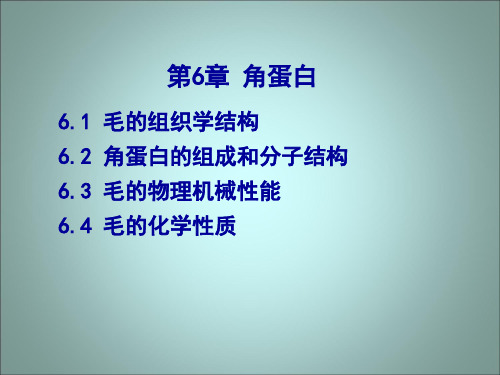
1.角蛋白肽链的一级结构特征 ➢存在两种基本肽链:Ⅰ型和Ⅱ型 ➢极性氨基酸含量>50%,酸碱性AA、Cys
含量高 2.角蛋白肽链的二级结构 ➢肽链的主要肽段为α-螺旋结构。 ➢链间双硫键赋予角蛋白高度稳定结构。
3. 角蛋白纤维的超分子结构
Ⅰ型和Ⅱ型肽链 构成复合螺旋结构
中间纤 丝
毛的角蛋白纤维
Ⅰ型和Ⅱ型肽链
H CC H 2SC H 2 C H 2SC H 2C H
通过对毛角蛋白双硫键的化学修饰,可以改善角蛋白 纤维的性质。
Ø与活性染料的反应
ü活性染料与纤维之间形成共价键交联,具有优良的耐湿擦 性质。
ü活性染料按照基团不同分为:均三嗪型、卤代嘧啶型、 乙烯砜型等。
ü反应机理:
均三嗪型、卤代嘧啶型
亲核取代
首尾轻度重 叠且交联
中间纤丝的结构模型
6.3 毛的物理机械性能
1.纺织用毛 2.毛的物理机械性能
1.纺织用毛
➢绵羊:绵羊毛、绵羊绒 ➢山羊:山羊毛、山羊绒 ➢骆驼:骆驼毛、骆驼绒 ➢驼羊:驼羊毛、骆马毛、秘鲁羊毛 ➢兔:兔毛、安哥拉兔毛、其它兔毛 ➢其它动物:牦牛绒
Merino
澳大利亚美利奴绵羊以产毛量高,羊毛品质好 而著称。
➢还原剂的作用——溶解或改性角蛋白
p发生位置:双硫键
p 双硫键的还原是一个可逆的平衡反应,过量的还 原剂有利于双硫键的还原。 p硫代物和硫化物、膦化物膦化物、亚硫酸盐等 都是双硫键的有效还原剂。
ü硫代物和硫化物
主要有巯基乙醇、邻甲苯硫酚、巯基乙酸、硫化钠等
双硫键的交换反应----亲核取代
H 2
H 2
乙烯砜型
亲核加成
作业
• 1.简述毛囊的结构。 • 2.简述毛蛋白的物理化学性质。
蛋白质的结构与功能(3)

这四种键能远小于共价键,称次级键
提问:次级键微弱但却是维持蛋白质三级结构中主 要的作用力,原因何在?
4.3. 蛋白质的变性与复性 4.3.1 蛋白质的变性
蛋白质的变性:是指蛋白质在某些物理和 化学因素作用下其特定的空间构象被改变, 从而导致其理化性质的改变和生物活性的 丧失,这种现象称为蛋白质变性。
主要有二大类:伴侣 蛋白、热激蛋白70家 族。
4.5 蛋白质构造的预测
1、运用物理化学的方法,测定蛋 白质 最低能量的构象。
需要复杂的数学运算。 目前很少获得 成功,但是对于研究蛋白
质的空间构象非常有用。
2、经历方法
比理论方法容易,也易成功
由Chou 和Fasman在70年代提出来
每种氨基酸出现在各种二级构造中倾向或者频率 是不同的
蛋白质分子为右手 -螺旋。
-螺旋
〔2〕 -折 叠
-pleated sheet
-折叠是由两条或多条几乎完全伸展的肽链 平行排列,通过链间的氢键交联而形成的。 肽链的主链呈锯齿状折叠构象
在-折叠中,-碳原子总是处于折叠的角上, 氨基酸的R基团处于折叠的棱角上并与棱角 垂直,两个氨基酸之间的轴心距为0.35nm
5). 构造域(domain)
分子较大的多肽链常折叠成两个或多个球 状簇,这种球状簇叫做域或构造域。
构造域是由几个超二级构造单位组成的, 大多数由100--200个氨基酸残基构成。 平均直径约2.5nm
构造域常具特殊功能,例如,结合小分子 (3-磷酸甘油醛脱氢酶同NAD的结合属 于这种情况) 。
4.2. 蛋白质空间构象稳定的因素 蛋白质多肽链在生理条件下折叠形成特定的空间构象
Quarternary structure
角蛋白结构功能与角蛋白遗传病ppt课件

V1、V2
可变区(Variable domains)
H1、H2
同源区( Homology regions)
ISIS
ISIS基元 (ISIS motif)
S
反向螺旋序列(Stutter sequence)
HIP/HTP
2019/9/5
7
角蛋白基因结构
I型:exons 1
introns
17
角蛋白中间丝的装配
2019/9/5
18
角蛋白遗传病基因突变 和临床系列研究
19
技术路线和实验方案
患者家系基因突变分析 收集患者家系临床资料、病理标本、采集外周血 提取外周血基因组DNA PCR扩增外显子 DNA序列分析 患者正常人同源性分析 确定 基因突变位点 排除多态性
20
先天性厚甲症(Pachyonychia congenita,PC)是一组常染色体显性 遗传病,特点是甲营养不良和不同程 度的外胚叶发育不良。
2 3 4 5 67 8 1 2 3 4 5 67
II型:exons 1
2
34 5 6 7
8
9
introns 1
2 34 5 6 7 8
2019/9/5
8
9
10
11
角蛋白不同结构区氨基酸数统计
角
蛋
V1 H1 1A L1 1B L12 2A L2 2B H2 V2
白
K1 644 144 36 35 11 102 17 19 8 121 20 131
K19
无异常表型
15
角蛋白与疾病
角蛋白 K1、K10 K5、K14 K6、K16、K17 K8、K18 K9 hHb6、 hHb1 K7、K15、K19、K20
《cp蛋白质》PPT课件
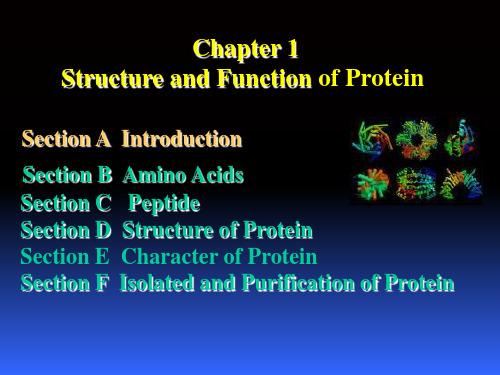
8
蛋白质的大小与分子量
蛋白质是分子量很大的生物分子.对任一种给定 的蛋白质来说,它的所有分子在氨基酸的组成和 顺序以及肽链的长度方面都应该是相同的,即所 谓均一的蛋白质.
蛋白质分子量的上下限是人为规定的,因为这决 定于蛋白质和分子量概念的定义.
31
肽键
肽键的特点是氮原子上的孤对电子与羰基具有 明显的共轭作用.
组成肽键的原子处于同一平面.
32
肽键
肽 键 中 的 C-N 键 具 有 部分双键性质,不能自 由旋转.
在大多数情况下,以反 式结构存在.
33
四肽的结构
34
C2 天然存在的重要多肽
在生物体中,多肽最重要的存在形式是作 为蛋白质的亚单位.
A rg
G ly N H 2
G ly N H 2
牛催产素
牛加压素
39
L-Leu-D-Phe-L-Pro-L-Val
L-Orn
L-Or
L-Val-L-Pro-D-Phe-L-Leu
短杆菌肽S<环十肽>
由细菌分泌的多肽,有时也都含有D-氨基酸和
一些不常见氨基酸,如鸟氨酸〔Ornithine, 缩写 为 Orn〕.
胞膜结构的破坏作用.
38
+H3N-Tyr-Gly-Gly-Phe-Met-COO- +H3N-Tyr-Gly-Gly-Phe-Leu-COO-
Met-脑啡肽
Leu-脑啡肽
C ys
C ys
Tyr
Tyr
IL e S
Phe S
G ln S
G ln S
A sn
A sn
- 1、下载文档前请自行甄别文档内容的完整性,平台不提供额外的编辑、内容补充、找答案等附加服务。
- 2、"仅部分预览"的文档,不可在线预览部分如存在完整性等问题,可反馈申请退款(可完整预览的文档不适用该条件!)。
- 3、如文档侵犯您的权益,请联系客服反馈,我们会尽快为您处理(人工客服工作时间:9:00-18:30)。
牦牛
阿坝州天然牧场
四川卧龙地区牦牛
➢ 牦牛主要分布在中 国、阿富汗、尼泊 尔等9个亚洲国家。 我国牦牛总头数及 其毛、绒产量均为 世界首位。
➢ 牦牛绒(毛)大多是 黑色、褐色。牦牛 绒由鳞片层与皮质 层组成,髓层极少 。
2.毛的物理机械性能
① 吸湿性 ② 弹性 ③ 应力-应变曲线 ④ 摩擦与缩绒性 ⑤ 耐热性
✓过氧化氢 进攻的对象:巯基(与角蛋白反应)
双硫键、色氨酰和酪氨酰的残基(有特定 的金属离子或有机酸)
pH的影响:
低pH值 巯基不易被氧化,但甲硫基的氧化则加速。
不同基团对氧化的敏感程度:
双硫键 <<<巯基、甲硫基 漂白:有效果,但一般。被二氧化硫、亚硫酸盐取代。
酸性条件下,用H2O2漂白可改善毛的品质。 碱性条件下,漂白效果较好,可能氧化双硫键。
第6章 角蛋白
6.1 毛的组织学结构 6.2 角蛋白的组成和分子结构 6.3 毛的物理机械性能 6.4 毛的化学性质
6.1 毛的组织学结构
(1)毛的结构 (2)毛囊的结构
(1)毛的构造
髓层
皮质层 鳞片层
美丽奴羊毛的鳞片层
毛的鳞片层
毛的鳞片层
(2)毛囊的结构
毛根鞘
毛干 脂腺 毛袋 毛根
毛乳头
✓过硼酸盐 用途:毛的洗涤、漂色及直毛过程中的巯基的中和。
✓其它氧化物
过碘酸、铬化合物、过锰酸盐、卤素及其衍生物。
制革氧化脱毛机理
H+
5NaClO 2 + 4HCl
4ClO 2 + 5NaCl + 2H2O
4 CH 2 S S CH2 + 10ClO2 + 4H 2 o
8 SO3 H + 5Cl 2
✓反应机理:
均三嗪型、卤代嘧啶型
亲核取代
乙烯砜型
亲核加成
作业
• 1.简述毛囊的结构。 • 2.简述毛蛋白的物理化学性质。
H2 HC C S
S
R + SH
H2C
CH2
H2 HC C S S R + RSH
SH H2C CH2 + R S S R
✓膦化物
三丁基膦(反应专一、条件温和、定量)
R
S S R + PR'3 + H2O
2RSH- + 2H+ + OPR'3
半胱氨酸
膦氧化物
✓亚硫酸盐
H2
H2
HC C S S C CH2 + NaHSO3
2.碱的作用– 碱对双硫键的水解作用、对盐
键、肽键的作用
角蛋白对碱极敏感,影响的程度与时间、 温度、浓度及碱的性质有关。
碱与双硫键的反应
CO HC CH2 S S
NH
CO
CO
CH 2
CH
OH -
H2 O
C- CH2
S
S
NH
NH
CO CH2 CH
NH
CO
C CH2 + - S S
NH
CO CH2 CH
①吸湿性
吸湿性好,回潮率一般在15%-16%,吸水率可 达60%。截面吸湿膨胀率17.5%-16%。
②弹性
由于毛纤维的分子结构特征,使其在一般情况下 有较好的弹性。
③应力-应变曲线
0 50% 100%
羊毛不同含水量的应力-应变曲线 几种纤维的应力-应变曲线
④摩擦与缩绒性
➢ 方向性摩擦效应 逆鳞片的摩擦系数大于顺鳞片的摩擦系数。
毛球
毛囊的组织切片图
• 毛能牢固地长在毛囊内的原因: 1. 毛囊把毛根紧紧包裹住 2. 毛球和毛乳头紧密相连
6.2 角蛋白纤维的组成和分子结构
羊毛纤维的主要蛋白质成分为角蛋白。 角蛋白也是动物毛发、表皮、趾甲、羽毛、角、 蹄等组织的主要蛋白组分。 ➢中间纤丝是角蛋白纤维的基本结构单元。
尺度介于小直径的肌动蛋白和粗大的肌球蛋白纤丝之 间,约为10nm。
➢还原剂的作用——溶解或改性角蛋白
发生位置:双硫键
双硫键的还原是一个可逆的平衡反应,过量的 还原剂有利于双硫键的还原。 硫代物和硫化物、膦化物膦化物、亚硫酸盐等 都是双硫键的有效还原剂。
✓硫代物和硫化物
主要有巯基乙醇、邻甲苯硫酚、巯基乙酸、硫化钠等
双硫键的交换反应----亲核取代
H2
H2
HC C S S C CH2 + RSH
首尾轻度重 叠且交联
中间纤丝的结构模型
6.3 毛的物理机械性能
1.纺织用毛 2.毛的物理机械性能
1.纺织用毛
➢绵羊:绵羊毛、绵羊绒 ➢山羊:山羊毛、山羊绒 ➢骆驼:骆驼毛、骆驼绒 ➢驼羊:驼羊毛、骆马毛、秘鲁羊毛 ➢兔:兔毛、安哥拉兔毛、其它兔毛 ➢其它动物:牦牛绒
Merino
澳大利亚美利奴绵羊以产毛量高,羊毛品质好 而著称。
➢ 缩绒性 羊毛在湿热条件下,经机械外力反复作用,纤维 集合体逐渐收缩紧密、交编毡化的性能。
⑤耐热性
羊毛耐干热性较差,在加工与使用过 程中,要求干热不超过70℃。在100℃105℃时,毛纤维很快失水、干燥而变的 脆弱、泛黄、强度降低。
6.4 毛的化学性质
1.酸的作用—对肽键的破坏
角蛋白对酸的耐受性较强,但高浓度强酸长时间 作用也会对毛纤维产生破坏。 低浓度的酸的主要作用是影响蛋白质的盐键。
C CH CH 2 S N
CO CH 2 NH
硫醚键交联
有Ca2+ 参与的新交联
CO
CO
C
CH2
+
2+ Ca
+
HS
CH2
CH
NH
NH
脱氢丙胺酰
CO
CO
CH CH2 Ca S CH2 CH
NH
NH
➢氧化剂的作用——溶解或改性角蛋白
发生位置:双硫键
无机过氧酸、有机过氧酸、过氧酸盐等都是双硫键的有 效氧化剂。
澳大利亚美利奴绵羊分三类:细毛美利奴绵羊、 中细毛美利奴绵羊、粗壮毛美利奴绵羊。
超细毛美利奴绵羊:直径16-17.5um,与山羊绒 相似,但成本低。
Cashmere(开士米)
Cashmere
mohair(马海毛)
马海毛是安哥拉山羊毛(土耳其安哥拉省)的音译商品 名称(Mohair)。南非、土耳其和美国为马海毛的三大产 地。马海毛长度12-26cm、直、有丝光。
1.角蛋白肽链的一级结构特征 ➢存在两种基本肽链:Ⅰ型和Ⅱ型 ➢极性氨基酸含量>50%,酸碱性AA、Cys
含量高 2.角蛋白肽链的二级结构 ➢肽链的主要肽段为α-螺旋结构。 ➢链间双硫键赋予角蛋白高度稳定结构。
3. 角蛋白纤维的超分子结构
Ⅰ型和Ⅱ型肽链 构成复合螺旋结构
中间纤 丝
毛的角蛋白纤维
Ⅰ型和Ⅱ型肽链
酶脱毛的机理: 中性和碱性的微生物蛋白酶
毛和毛囊连接部位的非胶原蛋白水解——毛与毛囊组织的分 离与脱落
6.毛的改性和修饰(交联反应)
通过对毛角蛋白双硫键的化学修饰,可以改善角蛋白 纤维的性质。
➢与活性染料的反应
✓活性染料与纤维之间形成共价键交联,具有优良的耐湿擦 性质。
✓活性染料按照基团不同分为:均三嗪型、卤代嘧啶型 、乙烯砜型等。
H2 SH H2C CH + HC C S SO3Na
半胱氨酰
S-磺基丙氨酰
常用的巯基封闭剂——碘化甲基汞CH3HgI
✓硫化钠、硫氢化钠
Na 2S
NaHS + NaOH
CH2 S S CH2 + 2NaHS
2 CH2SH + Na2 S2
5.酶(Enzyme)的作用
双硫键还原酶可对双硫键进行作用,从而水解 角蛋白纤维。
✓有机过氧酸
过甲酸、过乙酸是常用的有机过氧酸。
H2
H2
HC C S S C CH2 + 5RCO3H + H2O
H2 2 HC C SO3H + 5RCOOH
✓无机过氧酸
过二硫酸盐、酸性条件下—————毛的降解和脱色 作用对象:胱氨酰、甲硫氨酰、精氨酰、组胺酰、苯丙
氨酰等。
氧化机理:过氧化硫酸盐产生自由基进攻肽键。
NH
CO
C CH2 + - S
NH
CO
CH2 CH + S
NH
脱氢丙胺酰
硫代半胱氨酰
脱氢丙氨酰可发生新的交联反应——亲核加成
CO
+ C CH2
NH2 CH2
NH
CO CH NH
脱氢丙胺酰
C
CO
C CH2 + S N
CH2 CH NH
脱氢丙胺酰
CO CH NH
CH 2
NH
CO CH 2 NH
亚氨键交联
